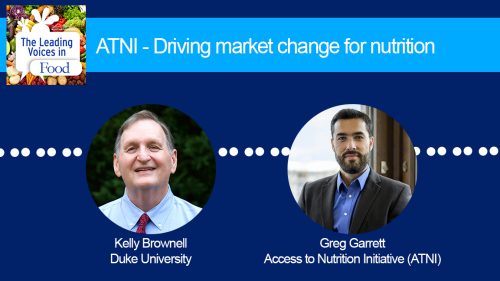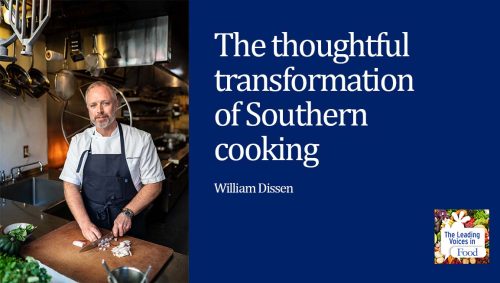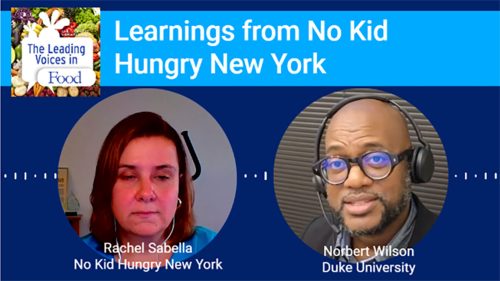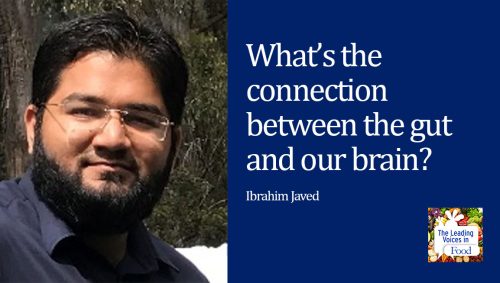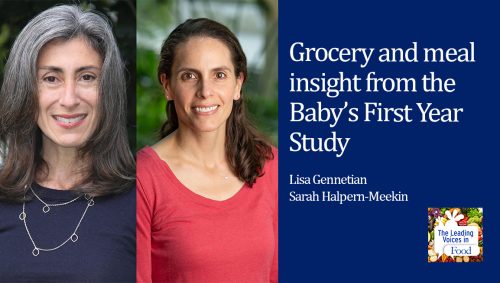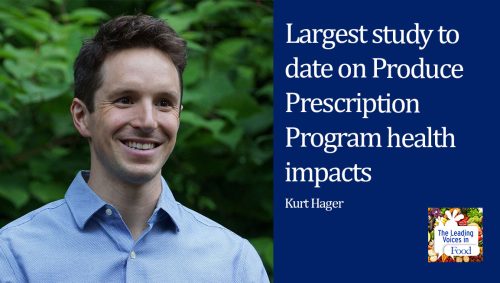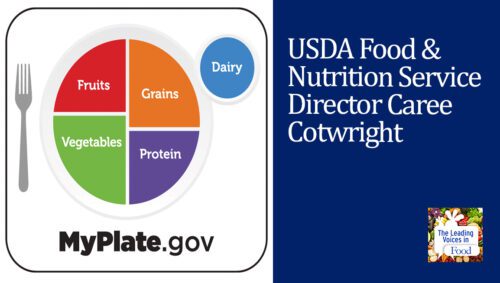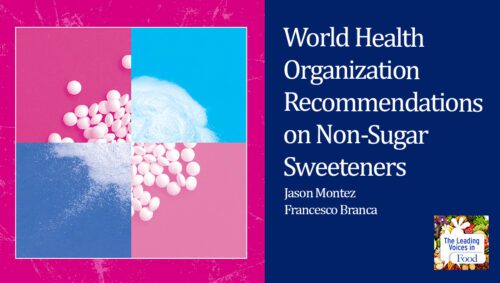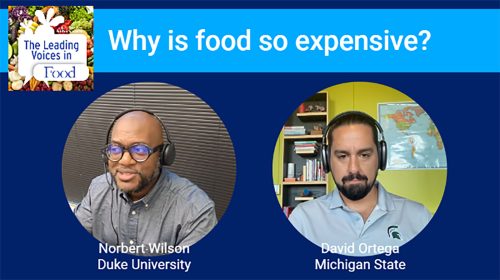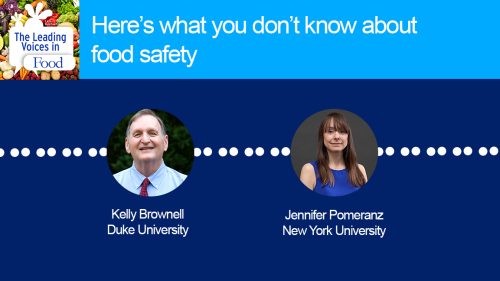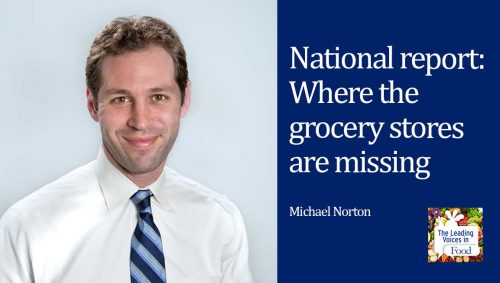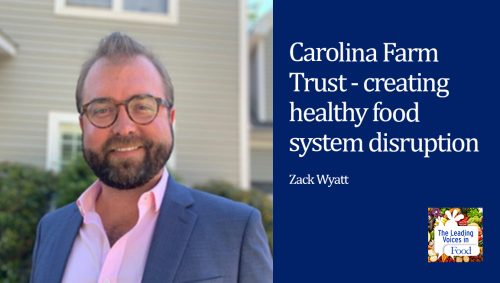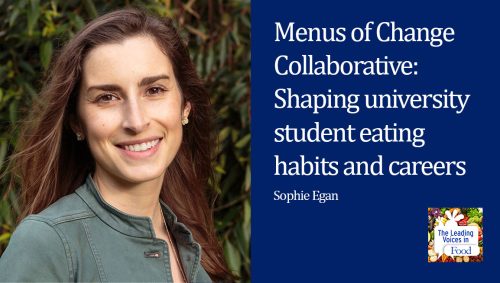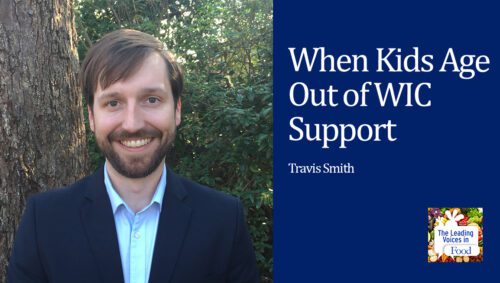The Leading Voices in Food
E238: Celebrating the Successes of the Alliance for a Healthier Generation
Nonprofit organizations can play a very important role in building healthy communities by providing services that contribute to community stability, social mobility, public policy, and decision-making. Today we’re speaking with Kathy Higgins, CEO of the Alliance for Healthier Generation. The Alliance is a nonprofit organization, a well-known one at that, that promotes healthy environments so that young people can achieve lifelong good health.

Kathy Higgins, chief executive officer (CEO) of the Alliance for a Healthier Generation, is a national expert on health care and philanthropy, having previously served as the president and CEO of the Blue Cross and Blue Shield of North Carolina Foundation. Higgins leads Healthier Generation’s team of nearly 100 professional staff across the nation working to make the healthy choice the easy choice for all children. Prior to taking on the role of Healthier Generation CEO in January 2019, Higgins spent more than 30 years at Blue Cross Blue Shield of North Carolina, where her roles span leading public health engagement, corporate communications, community relations, and corporate affairs. In 2000, Higgins led the launch of the Blue Cross NC Foundation. As president and CEO of the Blue Cross NC Foundation, Higgins led unprecedented growth, including the strategic investment of more than $150 million into North Carolina communities through more than 1,000 grants to improve the health of vulnerable populations, support physical activity and nutrition programs, and help nonprofit groups improve their organizational capacity. Higgins was also a significant advocate in Blue Cross NC’s early adoption of Healthier Generation’s decade-long innovative insurance benefit program, designed to encourage clinicians to extend weight management and obesity prevention services to kids and families. Higgins holds a bachelor’s degree in education from West Virginia Wesleyan College and completed her master’s work in community health education from Virginia Tech. She currently resides in Raleigh, North Carolina and is the mother to twin boys.
Interview Summary
Kathy, it’s really wonderful to reconnect. You and I interacted some when you were in North Carolina and head of the Blue Cross and Blue Shield of North Carolina Foundation, and then you got called upon to be the CEO of the Alliance, a really interesting position. It’s really wonderful to be able to talk to you again. Let’s start maybe with a little bit of the history of the Alliance for a Healthier Generation. Can you tell us a bit about how it got started and over the years, how it’s evolved?
We’ve existed for almost 19 years now. We celebrate our 20-year anniversary next year. And we were started by two vital public health forces: the Clinton Foundation and President Clinton and also the American Heart Association. They came together 20 years ago and began discussing childhood obesity and what could a leading public health organization do to really work in systems change across the country at a local level. It is those two organizations that we look to as our founders and who helped us advance our work.
It’s a time flies story because it seems like just yesterday that the Alliance was created. There was a lot of excitement at the time for it, and over the work. It’s done some really interesting things. So, in today’s iteration of the Alliance, what are some of the main areas of focus?
As I mentioned, we are a systems change organization. What we do is take a continuous improvement approach to advancing children’s health. So, we are working typically in schools or after school time and certainly in communities to work on policy and practice change that are about promoting physical activity and healthy eating. And then addressing critical child health and adolescent health issues, which as we know, were exacerbated with the pandemic. Things like food access and social connectedness are just so important. Quality sleep, which our children are not getting enough of, or other things like vaping and tobacco sensation and on time vaccinations. Another thing that we know is that the pandemic had a dramatic impact on families and children on time vaccinations. So, this is the work that we do and working with the policy and practice change so that there there can be opportunity for healthy environments for the children.
I think most everybody would probably agree that the targets that you’re working on, healthy diet, physical activity, smoking, vaping habits and things like that are really important. But people might be a little less familiar with what you mean by addressing systems. Could you give some examples of what you mean by that?
Right. What we know is that in United States, in fact, every public school must have a wellness policy and areas that need to be addressed. But what we’ll do is work with the school in making sure that those policies are best suited for the families, the community, and the school, and what they want to do to support the health of children from a collaborative and supportive role. What we know is that we can create great change when that occurs. We work with more than 56,000 schools across the United States, and one of the things that we know is that our approach is really reflected in the America’s Healthiest Schools recognition program each year.
It’s interesting to hear you talk about schools as an example of system change. And boy, working with 56,000 schools is pretty darn impressive. And it allows for out-sized influence of an organization like yours because if you can affect things like these school wellness policies and that gets multiplied across a ton of schools, it can really affect a lot of children.
Exactly. We will work school to school, but we also work in districts and that allows us then to make even a bigger impact in the number of schools that we’re reaching with these changes. It also brings the community together because then they’re all operating under the same principles or the same focus areas of the work that they’re committed to doing. What we do see is that we’re able to assist them in implementing what are typically best practices in all sorts of topic areas. Whether it’s strengthening the social emotional health and learning environment for the children, but also focusing on staff wellness. The whole notion, Kelly, of putting your oxygen mask on first before assisting others is something that has been incredibly important to us. We’ve certainly been very supported to do that work from a variety of funders. The other area that we’ve been able to make great strides in is this increasing of family and community engagement, which has been really significant for us. We’ve been honored to have Kohl’s as a major supporter of our work. Their investment and then reinvestment and then once again, another reinvestment, really helped us engage with strategies that focused on increasing family wellbeing. So really then our three-legged stool becomes the school environment, the family environment, and the community environment, which we find is just really effective.
So can we talk a little bit more about the community engagement and why is it important and how do you go about making it happen and what sort of impacts do you see it having?
I think I may have mentioned already that we do use a continuous improvement model that we find is just really effective for when we’re working in the school or school district level. It allows us to serve in a role of being a convener and bringing people together. What we know now is certainly after COVID that schools are no longer for walls of learning. They have a central role to the health of the community because of the services that they’re providing or the services that families need them to provide. So, when we’re working with a school, we’re able to convene the right people that are in their community. They may be in the same zip code, they may be down the street, they may be across town. But they haven’t come together around the same table to start to address issues that they may have prioritized that are impacting a host of things. It could be impacting attendance rates, it could be impacting academic achievement. And we’re really able to work with them to dismantle the barriers to what would lead to success. To give a couple examples in North Carolina, in fact, we work in both Bertie and Roberson County and on vaccination adherence, and also making sure that the children that may have deferred their well-child visits or their age-appropriate vaccinations during COVID that we’ve worked with convening just as mentioned, the right players, the right people in the community to come together. And in both those counties we’ve been able to have nearly 250 students that are healthy back to school and fully vaccinated as they should be and that they deserve to be and as their families wanted them to be, but the time the resources just wasn’t there or convenient enough to do. And so, this really has allowed the community to have a great win. It’s a great example of just the importance of sitting down together, looking at the data and thinking about how we can all make a difference.
Kathy, what you’ve reminded me of as you’ve been talking about this is that there’s sort of a sweet spot that you’ve attained. If all you paid attention to were best practices, you’d say, well, okay, everything that works in these other places is going to work in your place, which of course might only be partially true. But if you only work locally, then you’d miss the opportunity to be learning what’s happening elsewhere that might help you. And you’re kind of at the intersection of these things, aren’t you?
Thank you for saying that. That’s exactly where we sit – at that intersection. Sometimes we feel in a continuous improvement model that there’s a no wrong door, so to speak. And so, when we’re engaging with a school, school community, a community, or even a school district, that we’re able to sit with them in proximity and talk through what are the issues that they’re facing, where their children are most at risk, and what is it that they are working to prioritize. Because we also know that if we can move them through a process and achieve success and really answer the question, is anyone better off? So to really be outcomes focused. Then, what we know is that there are other opportunities for improvement that we can continue that work. Part of the success here is just pausing and celebrating what good work this community is doing together. This school is doing together.
Tell us if you will, a little bit about how the work of the Alliance is funded, because I know you draw support from a number of quarters. You mentioned Kohl’s, but overall how is the work funded?
Thanks for asking. You know, one of the things I did mention to start with is the Clinton Foundation and President Clinton, specifically with his leadership supporting the health of children and families and the Heart Association. But the significant financial supporter and strategic supporter at the time was the Robert Wood Johnson Foundation. They really put significant resources behind the creation of Healthier Generation. But the other thing that they did is put their brightest minds and public health leadership behind the creation of why we would exist and what would be the pillars of our organization that would serve well to make a difference. So having a technology backbone, which allows us to have an action center. Meaning that any school, any teacher, any administrator, any parent can access our training and our tools for free. Through our website, we have marketing and communication that follow best practices for how to create change and how to communicate change to the audiences that we’re reaching out to our subject matter expertise and then measurement and evaluation. And it’s this ability that really attracted funders like Kaiser Permanente. While schools have been central to our work, this digital platform really allowed our action center to help and support this access of no cost assessment tools, trainings, resources. Kaiser Permanente has been a key supporter of our work since 2013. I mentioned Kohl’s as well, as such a significant supporter allowing us to reach 10 million families since the inception of our work together with them. Del Monte Foods is another significant supportive of ours. They allow us to implement the America’s Healthiest School Awards program. I would be lost if I didn’t mention Mackenzie Scott. She wanted to invest in whole child health equity and we were identified as an organization that was worthy of her funding and definitely was the largest single gift from a philanthropist that we’ve ever received. So, we were so grateful for that, that call called.
That’s wonderful affirmation. No question. It’s nice to hear you have such a broad base of funding because that’s a sign that people are thinking you’re doing things right. I’m not sure I’m in a the best position to be completely objective about this because over the years I’ve received funding from through Robert Wood Johnson Foundation for a number of projects. But it’s amazing how often their imprint comes up when you talk about organizations that are doing creative work and you go back to the beginnings and Robert Wood Johnson was often there doing these things when nobody else was. And it’s really wonderful to see the long-term consequence of that investment that they made. Well, let’s talk about some new work you’re doing in the schools. I know that a relatively new effort of the Alliance involves the expansion of resources in terms of a playbook in the schools. Can you explain what that’s all about?
Oh yes. This was really born out of the pandemic environment and our need and the schools need to know better guidance on the work that we can do to create healthier environments when so many demands are being put on us. We all know what happened to the food service staff of any school. They became the food service staff of the community during the COVID years. Kohl’s wanted us to partner with selected communities across the country to implement what would be really a new family engagement strategy to support children’s health and developing. What we call and refer to as our Healthy at Home playbook for schools to forge stronger relationships with families. We know that when schools and the families are working together and schools are understanding what families need, and families are able to be in a position to be heard and communicate what their needs are, that together they can really make a difference. We’ve been pretty excited the collection of resources. They’re both in English and in Spanish on topics such as nutrition, staying active, mental wellbeing, social emotional health and stress and we’ve been pretty excited to have that implemented.
I could see how you’d be excited about that. So, let me ask a final question. The word policy has come up several times. Is it part of the purview of the alliance to argue for policy changes? You mentioned schools. So, for example, would the Alliance be in a position to argue for tighter nutrition standards in schools or even something beyond the schools, like something dealing with food marketing directed at kids or front of package labeling or really anything like that?
We stay out of the advocacy and lobbying lane, but we do focus on the small P policy change in schools so that we’re helping schools manage their policies. But the area where we’ve had success is in creating a difference. We had a great partnership many years ago with McDonald’s and worked with them on changes that they were committed to making in their healthy meals. And what we know is when McDonald’s makes a big shift, so goes the market. Our body of work was the removing of sugary sodas from the menu board so that you would have to opt for that versus low fat milk or water and adding the sliced apples. I think that might be one of our hallmarks of the work that we’ve done over the years: sliced apples, carrot sticks, the GO-GURT that was being offered. And then removing either the higher sodium or higher fat items from the leaderboards so that they have to ask for them in order to have them as part of the Happy Meal. That was some significant work that we were able to do. And the other work we did in our early years was getting the three soda manufacturers, whether Pepsi and Coke and Dr. Pepper to agree to come together and remove sugar sodas from our public schools and replace it with a better price point of water. And it’s something I know President Clinton is very proud of because I think a 90% of schools were on board with that work after about a three-year period. I think it really made a difference.


